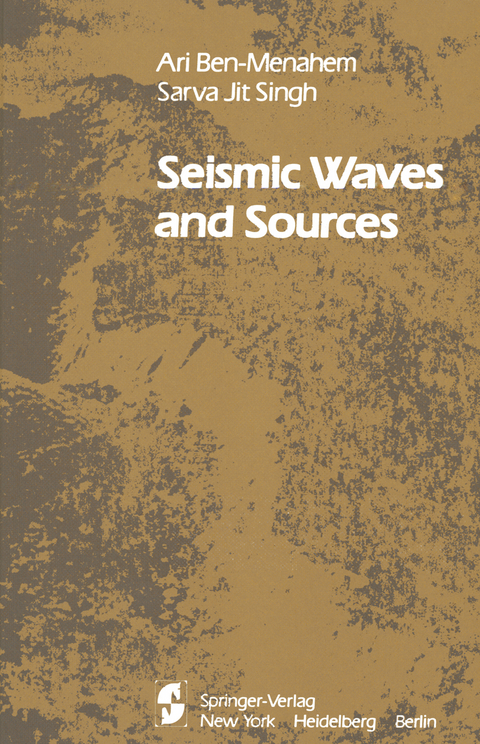
Seismic Waves and Sources
Springer-Verlag New York Inc.
978-1-4612-5858-2 (ISBN)
Earthquakes come and go as they please, leaving behind them trails of destruc tion and casualties. Although their occurrence is little affected by what we do or think, it is the task of earth scientists to keep studying them from all possible angles until ways and means are found to divert, forecast, and eventually control them. In ancient times people were awestruck by singular geophysical events, which were attributed to supernatural powers. It was recognized only in 1760 that earthquakes originated within the earth. A hundred years later, first systematic attempts were made to apply physical principles to study them. During the next century scientists accumulated knowledge about the effects of earthquakes, their geographic patterns, the waves emitted by them, and the internal constitution of the earth. During the past 20 years, seismology has made a tremendous progress, mainly because of the advent of modern computers and improvements in data acquisi tion systems, which are now capable of digital and analog recording of ground motion over a frequency range of five orders of magnitude. These technologic developments have enabled seismologists to make measurements with far greater precision and sophistication than was previously possible. Advanced computational analyses have been applied to high-quality data and elaborate theoretical models have been devised to interpret them. As a result, far reaching advances in our knowledge of the earth's structure and the nature of earthquake sources have occurred.
1 Classical Continuum Dynamics.- 1.1. The Stress Dyadic and Its Properties.- 1.2. Geometry of Small Deformations.- 1.3. Linear Elastic Solid.- 1.4. The Field Equations.- 1.5. Lagrangian Formulation.- 1.6. One-Dimensional Approximations.- 1.7. Two-Dimensional Approximations.- 1.8. Representation of Finite Strains.- 2 Waves in Infinite Media.- 2.1. Elementary Solutions of the Wave Equation.- 2.2. Separability of the Scalar Helmholtz Equation.- 2.3. Separability of the Vector Helmholtz Equation.- 2.4. Eigenvector Solutions of the Navier Equation.- 2.5. Plane Waves.- 2.6. Interrelations Among Plane, Cylindrical, and Spherical Waves.- 2.7. Dyadic Plane Waves.- 3 Seismic Plane Waves in a Layered Half-Space.- 3.1. Reflection and Refraction of Plane Waves- General Considerations.- 3.2. Reflection at a Free Surface.- 3.3. Reflection and Refraction at a Solid-Solid Interface.- 3.4. Reflection and Refraction at a Solid-Liquid Interface.- 3.5. Reflection and Refraction at a Liquid-Solid Interface.- 3.6. Surface Waves.- 3.7. Spectral Response of a Multilayered Crust.- 3.8. Generalization of the Matrix Method—the Matrix Propagator.- 3.9. The Inverse Surface-Wave Problem.- 4 Representation of Seismic Sources.- 4.1. A Concentrated Force in a Homogeneous Medium.- 4.2. Dipolar Point Sources.- 4.3. Relations of Betti, Somigliana, and Volterra.- 4.4. Fault-Plane Geometry.- 4.5. Dipolar Sources in a Homogeneous Medium.- 4.6. Stress Distributions on a Spherical Cavity and Their Equivalent Sources.- 4.7. Radiations from a Finite Moving Source.- 4.8. Radiation of Elastic Waves by Volume Sources.- 5 Surface-Wave Amplitude Theory.- 5.1. Surface-Wave Amplitudes in Simple Configurations.- 5.2. Generalization to a Vertically Inhomogeneous Half-space.- 5.3. Surface Waves from a Finite MovingSource.- 6 Normal-Mode Solution for Spherical Earth Models.- 6.1. Introduction.- 6.2. Oscillations of a Homogeneous Sphere.- 6.3. Oscillations of a Radially Inhomogeneous Self-Gravitating Earth Model.- 6.4. Effect of the Rotation of the Earth.- 6.5. Energy Integrals.- 6.6. Source Effects.- 6.7. Numerical Procedures.- 7 Geometric Elastodynamics: Rays and Generalized Rays.- 7.1. Asymptotic Body Wave Theory.- 7.2. Ray-Amplitude Theory.- 7.3. Ray Theory in Vertically Inhomogeneous Media.- 7.4. Asymptotic-Wave Theory in Vertically Inhomogeneous Media.- 7.5. Breakdown of the GEA: Caustics.- 7.6. Theoretical Seismograms.- 7.7. Spectral Asymptotic Approximations.- 7.8. Initial Motions.- 7.9. Normal-Mode versus Ray Solutions for Vertically Inhomogeneous Media.- 8 Asymptotic Theory of the Earth’s Normal Modes.- 8.1. Jeans’ Formula.- 8.2. Watson’s Transformation of the Spectral Field.- 8.3. Surface Waves on a Sphere.- 8.4. Mode-Ray Duality.- 8.5. Ray Analysis in a Homogeneous Sphere.- 8.6. SH-Fild Analysis in a Uniform Shell Overlying a Fluid Core.- 8.7. Generalized Rays in Spherical-Earth Models.- 9 Atmospheric and Water Waves and Companion Seismic Phenomena.- 9.1. The Navier-Stokes Equation.- 9.2. Sound Waves.- 9.3. Gravity Waves in Liquids.- 9.4. Acoustic-Gravity Waves in the Atmosphere.- 9.5. Waves Generated by Atmospheric Explosions.- 9.6. Coupled Air-Sea Waves.- 9.7. Rayleigh Waves from Atmospheric Explosions.- 10 Seismic Wave Motion in Anelastic Media.- 10.1. The Specific Dissipation Parameter.- 10.2. Linear Viscoelastic Solid.- 10.3. Pulse Propagation in Unbounded Anelastic Media.- 10.4. Attenuation of Seismic Waves in the Earth.- Appendices.- A. Algebra and Calculus of Dyadics.- B. Orthogonal Curvilinear Coordinates.- C. The Material Derivative.- D. Bessel andLegendre Functions.- E. Asymptotic Evaluation of Special Integrals.- F. Generalized Functions.- G. The Airy Integral.- H. Asymptotic Solutions of Second-Order Linear Differential Equations.- I. Generalized Spherical Harmonics.- J. Transformation of Wave Functions under Translation and Rotation of the Coordinate Axes.- K. The Mathematics of Causality.- L. Models of the Earth and the Atmosphere.- List of Symbols.- Author Index.
| Zusatzinfo | XXI, 1108 p. |
|---|---|
| Verlagsort | New York, NY |
| Sprache | englisch |
| Maße | 155 x 235 mm |
| Themenwelt | Naturwissenschaften ► Geowissenschaften ► Geologie |
| Naturwissenschaften ► Geowissenschaften ► Geophysik | |
| Naturwissenschaften ► Physik / Astronomie | |
| Schlagworte | Erdbeben |
| ISBN-10 | 1-4612-5858-8 / 1461258588 |
| ISBN-13 | 978-1-4612-5858-2 / 9781461258582 |
| Zustand | Neuware |
| Haben Sie eine Frage zum Produkt? |
aus dem Bereich


